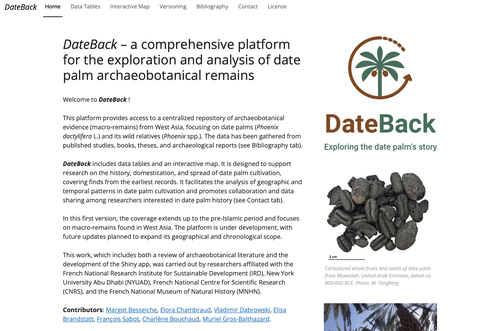
MORICCA Claudia
- Environmental Biology, Sapienza University of Rome, Rome, Italy
- Archaeobotany, Environmental archaeology, Paleoenvironment
Recommendations: 0
Review: 1
Review: 1

DateBack, an evolving open-access repository of Phoenix archaeobotanical data supporting new perspectives on the history of date palm cultivation
Recommendation for the Publication of DateBack: An Open Archaeobotanical Repository
Recommended by Claudia Speciale based on reviews by Claudia Moricca and 1 anonymous reviewerI wholeheartedly recommend the publication of "DateBack, an evolving open-access repository of Phoenix archaeobotanical data supporting new perspectives on the history of date palm cultivation" (Besseiche et al. 2025). This work emerges at a crucial moment in archaeobotanical research, responding to calls for more integrative, open-access data infrastructures (e.g. Lodwick 2019; Reiter et al. 2024) that enable comparative studies across time and space.
The authors address a key question in agricultural and environmental history: how, when, and where did humans shape the distribution and cultivation of Phoenix dactylifera? They hypothesize that only through standardized, large-scale archaeobotanical data, long-standing narratives of domestication and dispersal can be assessed. To test this, they introduce DateBack, a curated database that aggregates published and unpublished archaeobotanical evidence, including seed morphometrics, radiocarbon dates, and contextual metadata.
The methodology is rigorous and transparent, involving systematic data collection, harmonization, and open-source publication following FAIR principles. The database’s preliminary results already suggest regionally distinct cultivation trajectories and long-distance interactions shaping date palm history, particularly in North Africa and the Arabian Peninsula.
I recommend the paper because it sets a new standard for data sharing in archaeobotany, moving beyond isolated case studies toward reproducible, collaborative science. The project fills a critical infrastructure gap and will likely catalyze new cross-disciplinary research. Its relevance extends from archaeology and botany to digital humanities and heritage data management.
In sum, DateBack is a timely and necessary resource, and I wish its publication will have a lasting impact on the field.
References
Margot Besseiche, Elora Chambraud, Vladimir Dabrowski, Elisa Brandstatt, François Sabot, Charlène Bouchaud, Muriel Gros-Balthazard (2025). DateBack, an evolving open-access repository of Phoenix archaeobotanical data supporting new perspectives on the history of date palm cultivation. bioRxiv, ver.2 peer-reviewed and recommended by PCI Archaeology https://doi.org/10.1101/2025.02.21.639487
Lodwick, L. (2019). Sowing the Seeds of Future Research: Data Sharing, Citation and Reuse
in Archaeobotany. Open Quaternary, 5, 7. https://doi.org/10.5334/oq.62
Reiter, S. S., Staniuk, R., Kolář, J., Bulatović, J., Rose, H. A., Ryabogina, N. E., ... & Timpson, A. (2024). The BIAD Standards: Recommendations for Archaeological Data Publication and Insights From the Big Interdisciplinary Archaeological Database. Open Archaeology, 10(1), 20240015. https://doi.org/10.1515/opar-2024-0015